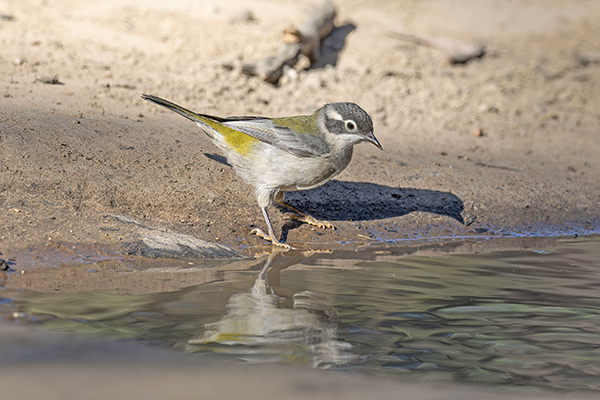Theres a huge variety of Honeyeaters in Australia with many having either a very restricted range or on the verge of extinction (Regents Honeyeater). They all have a brush tipped tongue to collect nectar from flowers but also eat insects. Outside the breeding season flocks forage for good feeding areas and water and good numbers can be seen by staking out either. The nearby dam that has attracted the parrots has als oattrted numerous Honeyeaters and its a fantastic site seeing these woodland gems coming to drink in large numbers. Theres even been an out of range White-fronted Honeyeater that I was lucky enough to see but it didn't stay long enough for me to put down the binoculars and pick up the camera.
Our daughter's garden is right on the edge of bushland reserve and small numbers of honeyeaters have been visiting the myrtle bush thats still flowering. Most are White-plumed Honeyeater but I've been luckyt enough to see both Yellow-faced and Yellow-tufted in the garden recently.
Below: Yellow-faced Honeyeater in Amy's garden
Below: Yellow-tufted Honeyeater in Amy's garden
Meanwhile, back at the dam, the range of species and sheer numbers of honeyeaters coming down to drink was almost overwhelming!


 |
|
 |
|
 |
Above: Black-chinned Honeyeater
Below: Brown- headed Honeyeater
Below : Fuscous Honeyeater
Below: White-naped Honeyeater
Below: Yellow-tufted Honeyeater
Below : White-plumed Honeyeater
It was fascinating to watch the dynamics between the species. The larger and more numerous White-plumed and Yellow-tufted Honeyeaters were quite belligerent and spent a lot of time chasing each other and there was lots of bickering whereas the similar looking Black-chinned, White-naped and Brown- headed Honeyeaters were more tolerant of each other.
Red-wattlebirds are the second largest Honeyeater in Australia and ubiquitous in gardens and parklands. Even so, it was noce to see a few coming down to drink and pose nicely for the camera.
I was also pleased to see a pair of Crested (now Eastern) Shrike-tits come down to drink. A species I've only seen in dense woodland before and never managed to get a photo of.
Female Eastern Shrike Tit with duller breast band and crest
Male Eastern Shrike Tit with blacker crest and breast band
Looking like the love child between a Crested Tit and a Great Tit these only came in to drink infrequently and not every visit. Having the birds come so close to drink, and in such good numbers, has been fantastic and helped immensely with my Australian bird call identification skills!
|






















































































No comments :
Post a Comment